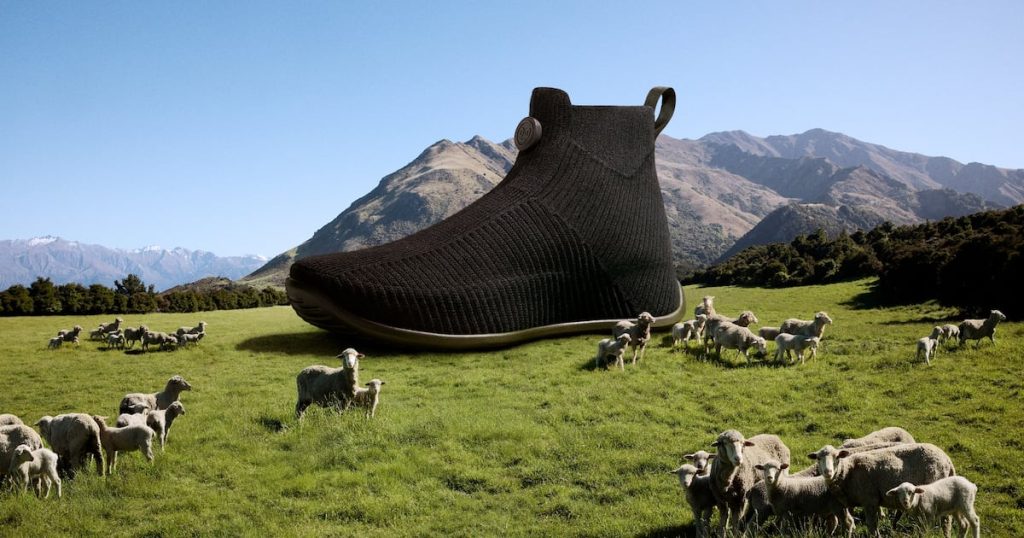
A little under two years ago, footwear brand Allbirds announced it had developed a breakthrough new shoe, a slip-on wool sneaker with a carbon footprint that netted out to nothing.
The sock-like Mo.onshot was meant to underpin the struggling sneaker maker’s turnaround efforts, positioning the company as a leader in both innovation and environmental stewardship.
But when the shoe finally lands in stores this month with a limited release of 500 pairs, it will be entering a market where the ability of earth-friendly marketing messages to generate the kind of heat the brand is banking on to juice sales and return to growth is increasingly in doubt.
Sustainability, once a hot buzzword, has become a liability for many brands, with consumers wary of greenwashing. Values-driven messaging is increasingly viewed as preachy, rather than aspirational; limited drops of innovations that never scale have become routine, rather than exciting. At the same time, brands are grappling with a broader cultural vibe shift, especially in the US, where a backlash against “woke capitalism” has prompted many businesses to pull back from public commitments to diversity and sustainability.
Put bluntly, sustainability is just “not as sexy any more,” said Eduardo Andrade, a professor of marketing at Imperial College London.
Sustainability Doesn’t Sell
When Allbirds launched in 2016, the market looked very different. The direct-to-consumer boom of the 2010s was still in its infancy, with start-up brands finding huge success with hero products and marketing strategies that tapped into environmentally and socially conscious values that many young, engaged communities of consumers claimed they wanted to see represented in the brands they shopped.
Sustainability was viewed as a winning sales strategy, with the womenswear brand Reformation and basics specialist Everlane among those using supply chain transparency and carbon calculators to attract conscious consumers. Allbirds’ popular wool runners and earth-friendly marketing also fit perfectly into the niche.
But optimistic projections that consumer demand would lead a wholesale shift to a friendlier form of more ethical capitalism hasn’t played out. Consumers will still consistently say they care about sustainability when asked if it factors into shopping decisions in surveys. But ask them instead to rank what they think about when making a purchase and the topic frequently falls off the list altogether, replaced by considerations such as price, quality and aesthetics, said Andrade.
“The idea that the planet and profit are naturally aligned… was very appealing, but it was never much there in the first place,” he added. “The narrative has changed much more than consumer preferences.”
The challenge for brands like Allbirds isn’t just about messaging, either. Companies that want to operate sustainably typically face higher costs and more limited sourcing opportunities than competitors more willing to bend standards to access cheaper materials and factories. That means higher prices at a time when consumers are tightening their belts.
Allbirds is not the only business struggling; it is just one of the most publicly scrutinised. A flurry of sustainability focussed brands went under last year, victims of a “slow-fashion recession” that highlighted just how challenging it is to try and run a fashion business that takes care of people and planet and still turns a profit, even when targeting a niche of engaged consumers. Meanwhile, the most successful fashion brand of the decade is arguably Shein, an ultra-fast-fashion business that ranks as the industry’s top polluter.
“Part of me thinks the consumer just wants to get away from it all,” said Dana Davis, who ran sustainability, product and business strategy at Mara Hoffman — the slow fashion recession’s highest-profile casualty. “They don’t want to feel pressure when choosing what to buy.”
Down, But not Out
Allbirds says the strategy for its latest launch is intended to combat many of these exact challenges.
Previously the brand has led with more scientific messaging, labelling its products with a carbon “calorie count” and open-sourcing a toolkit explaining how it tackled emissions reductions in design and production. This time, the focus is on nature, innovation and overcoming the odds to deliver on a “moonshot” challenge with its zero-carbon shoe.
“People respond to texture and feel and beauty and creativity and ideas about what the future should be,” said Allbirds co-founder Tim Brown. “Science isn’t enough.”
There’s a lot riding on Mo.onshot’s success. Allbirds is in the middle of a turnaround plan to return to sales growth and generate profits by the end of this year. In its most recent earnings in November, the brand reported a 25 percent year-over-year sales drop to $43 million with a $21 million net loss.
Allbirds is banking on new product launches to drive growth. Recent launches have included updates of its classic items, such as new midsoles on the brand’s Wool Runner and Tree Runner, and a few newer silhouettes including a low-top slip-on called the Lounger Lift. Mo.onshot is by far Allbirds’ splashiest bet, but its rollout is less ambitious than its design. The shoe will only be available in stores in New York, London, Dubai, Seoul and Tokyo.
“They’re trying to get back to what that initial customer sought them out for. The Mo.onshot is a distraction from that,” said Dylan Carden, research analyst at financial services firm William Blair. “You’re losing customer mindshare as you’re going through this type of decline, and so it’s not a given that you’re going to be able to put a different shoe in front of that customer.”
But Allbirds’ decision to release only 500 pairs of Mo.onshot is a sign that the shoe plays a bigger role in the brand’s renewed focus on climate-driven messaging than as a potential sales driver. The shoes will only be sold in retail stores and not online to limit the amount of packaging used and reduce the product’s carbon footprint, the company said.
“Is it a case at the moment where sustainability itself is out of fashion? You could make that argument,” said Brown. “This is an example of us doing something that is at the core of why we started the business… We believe now more than ever this adds up to a really bright future.”
Many consumers do still care about the planet, even if it is not their first consideration when making a purchase. And it remains to be seen how increasingly frequent and fierce disasters, like the fires that blazed across LA in January, will influence the purchasing behaviour of affected communities. For now, the brands with a sustainability message that are still winning — companies like Scandi-cool label Ganni and Californian “hot-girl” brand Reformation — treat the topic with a degree of irreverence and put the product first.
For consumers, the key questions are “is the product great? Is it an incredible design?” said Quynh Mai, founder of digital creative agency Qulture. But if a brand can hit those marks and offer a product with a credible claim to be more sustainable, then that can “tip consumers over to considering that brand,” she added.








